Twisted Dual-Cycle Fiber Optic Bending Loss Characteristics for Strain Measurement
Abstract
:1. Introduction
2. Twisted Dual-Cycle Bending Loss Characteristics
2.1. Twisted Dual-Cycle Bending Structure
2.2. Bending Loss Characteristics
3. FOS Head Bonded to the FRP Composite Coupon
- (a)
- Attach three sheets of double-sided tape (93015LE, 3M, Maplewood, MN, USA) in two strips to the surface of the FRP coupon. Each strip of double-sided tape fixes one end of the steel wire, leaving the middle part of the coupon without tape for the passage of the optical fiber.
- (b)
- Place the steel wire on top of the double-sided tape under the conditions listed in Table 1. The sensor length depends on the number of steel wires and the distance between these wires.
- (c)
- Fix both ends of the steel wire to the surface of the FRP coupon.
- (d)
- Weave the single-mode optical fiber over and under the steel wires as they pass across the specimen.
- (e)
- Fix the optical fiber to the FRP coupon surface with epoxy resin 20 mm from the left-most steel wire. After the epoxy resin is fully cured, connect the spring to the round structure for returning the optical fiber. Pull the spring to apply force to the optical fiber for setting the operating point of the sensor head that the optical power loss can be linearly operated according to the strain applied to the FRP coupons.
- (f)
- Fix the optical fiber to the FRP coupon surface with epoxy resin 20 mm from the right-most steel wire. Remove the round structure and the spring after the epoxy resin has fully cured.
4. Measurement of FRP Coupon Strain
4.1. Tensile Strain Test
4.2. Three-Point Bending Test
5. Conclusions
Author Contributions
Funding
Conflicts of Interest
References
- López-Higuera, J.M.; Cobo, L.R.; Incera, A.Q.; Cobo, A. Fiber optic sensors in structural health monitoring. IEEE J. Lightwave Tech. 2011, 29, 587–608. [Google Scholar] [CrossRef]
- Yin, S.S.; Ruffin, P.B.; Yu, F.T.S. Overview of fiber optic sensors. In Fiber Optic Sensors, 2nd ed.; CRC Press: Boca Raton, FL, USA, 2008; pp. 1–2. ISBN 9781420053654. [Google Scholar]
- Choi, S.J.; Kim, Y.C.; Song, M.; Pan, J.K. A self-referencing intensity-based fiber optic sensor with multipoint sensing characteristics. Sensors 2014, 14, 12803–12815. [Google Scholar] [CrossRef] [PubMed]
- Silva, R.M.; Baptista, J.M.; Santos, J.L.; Lobo Ribeiro, A.B.; Araújo, F.M.; Ferreira, L.A.; Frazão, O. A simple, self-referenced, intensity-based optical fibre sensor for temperature measurements. Opt. Commun. 2013, 291, 215–218. [Google Scholar] [CrossRef]
- Spillman, W.B.; Lord, J.R. Self-referencing multiplexing technique for fiber-optic intensity sensors. IEEE J. Lightwave Technol. 1987, 5, 865–869. [Google Scholar] [CrossRef]
- García, C.V.; Montalvo, J.; Lallana, P.C. Radio-frequency ring resonators for self-referencing fibre-optic intensity sensors. Opt. Eng. Lett. 2005, 44, 040502. [Google Scholar] [CrossRef] [Green Version]
- Vázquez, C.; Montalvo, J.; Montero, D.S.; Pena, J.M.S. Self-referencing fiber-optic intensity sensors using ring resonators and fiber Bragg gratings. IEEE Photon. Technol. Lett. 2006, 18, 2374–2376. [Google Scholar] [CrossRef] [Green Version]
- Montalvo, J.; Frazão, O.; Santos, J.L.; Vázquez, C.; Baptista, J.M. Radio-frequency self-referencing technique with enhanced sensitivity for coarse WDM fiber optic intensity sensors. IEEE J. Lightwave Technol. 2009, 27, 475–482. [Google Scholar] [CrossRef] [Green Version]
- Montero, D.S.; Vázquez, C. Remote interrogation of WDM fiber-optic intensity sensors deploying delay lines in the virtual domain. Sensors 2014, 13, 5870–5880. [Google Scholar] [CrossRef] [PubMed] [Green Version]
- Perez-Herrera, R.A.; Pereira, D.A.; Frazão, O.; Castro Ferreira, J.M.; Santos, J.L.; Araújo, F.M.; Ferreira, L.A.; Baptista, J.M.; Lopez-Amo, M. Optimization of the frequency-modulated continuous wave technique for referencing and multiplexing intensity-based fiber optic sensors. Measurement 2011, 44, 230–237. [Google Scholar] [CrossRef]
- Montalvo, J.; Araújo, F.M.; Ferreira, L.A.; Vázquez, C.; Baptista, J.M. Electrical FIR filter with optical coefficients for self-referencing WDM intensity sensors. IEEE Photon. Technol. Lett. 2008, 20, 45–47. [Google Scholar] [CrossRef] [Green Version]
- Wang, Q.; Farrell, G.; Freir, T. Theoretical and experimental investigations of macro-bend losses for standard single mode fibers. Opt. Express 2005, 13, 4476–4484. [Google Scholar] [CrossRef] [PubMed]
- Harris, A.J.; Castle, P.F. Bend loss measurements on high numerical aperture single-mode fibers as a function of wavelength and bend radius. IEEE J. Lightwave Technol. 1986, 4, 34–40. [Google Scholar] [CrossRef]
- Faustini, L.; Martini, G. Bend loss in single-mode fibers. IEEE J. Lightwave Technol. 1997, 15, 671–679. [Google Scholar] [CrossRef]
- Renner, H. Bending losses of coated single-mode fibers: A simple approach. IEEE J. Lightwave Technol. 1992, 10, 544–551. [Google Scholar] [CrossRef]
- Lu, W.H.; Chen, L.W.; Xie, W.F.; Chen, Y.C. A sensing element based on a bent and elongated grooved polymer optical fiber. Sensors 2012, 12, 7485–7495. [Google Scholar] [CrossRef] [PubMed]
- Kuang, J.H.; Chen, P.C.; Chen, Y.C. Plastic optical fiber displacement sensor based on dual cycling bending. Sensors 2010, 10, 10198–10210. [Google Scholar] [CrossRef] [PubMed]
- Wang, W.C.; Ledoux, W.R.; Sangeorzan, B.J.; Reinhall, P.G. A shear and plantar pressure sensor based on fiber-optic bend loss. J. Rehabil. Res. Dev. 2005, 42, 315–325. [Google Scholar] [CrossRef] [PubMed]
- Abe, T.; Mitsunaga, Y.; Koga, H. A strain sensor using twisted optical fibers. IEEE J. Lightwave Technol. 1989, 7, 525–529. [Google Scholar] [CrossRef]
- Zendehnam, A.; Mirzaei, M.; Farashiani, A.; Farahani, L.H. Investigation of bending loss in a single-mode optical fibre. Pramana-J. Phys. 2010, 74, 591–603. [Google Scholar] [CrossRef]
- Qiu, J.; Zheng, D.; Zhu, K.; Fang, B.; Cheng, L. Optical fiber sensor experimental research based on the theory of bending loss applied to monitoring differential settlement at the earth-rock junction. J. Sens. 2015, 2015, 346807. [Google Scholar] [CrossRef]
- Marcuse, D. Curvature loss formula for optical fibers. J. Opt. Soc. Am. 1976, 66, 216–220. [Google Scholar] [CrossRef]
- Song, H.C.; Yum, J.S. A study of the mechanical properties of fiberglass reinforcements with constitution of lay-up, manufacturing method, and resins. J. Ocean. Eng. Technol. 2010, 24, 75–80. [Google Scholar]
- Čapek, J.; Vojtěch, D.; Oborná, A. Microstructural and mechanical properties of biodegradable iron foam prepared by powder metallurgy. Mater. Des. 2015, 83, 468–482. [Google Scholar] [CrossRef]


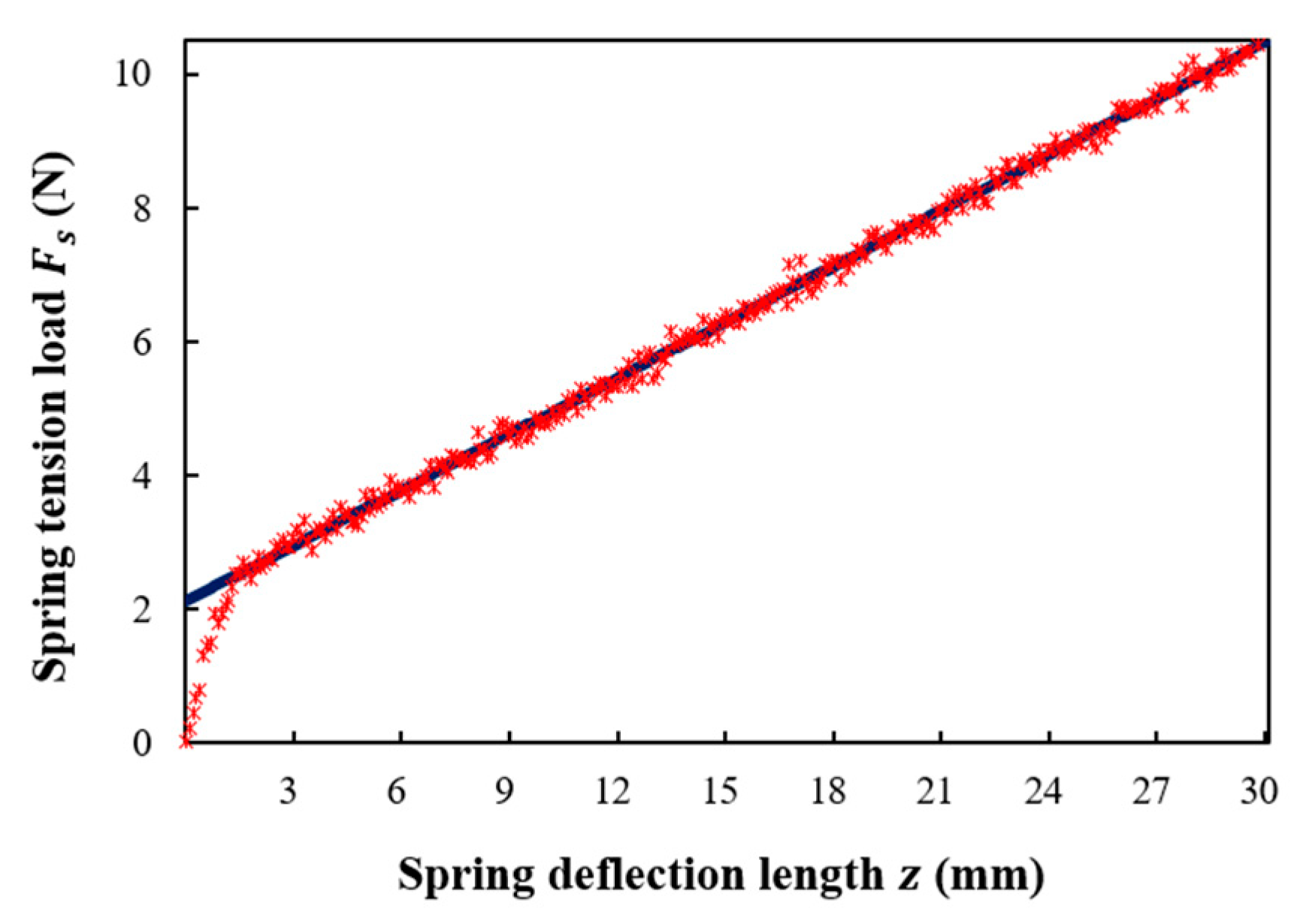
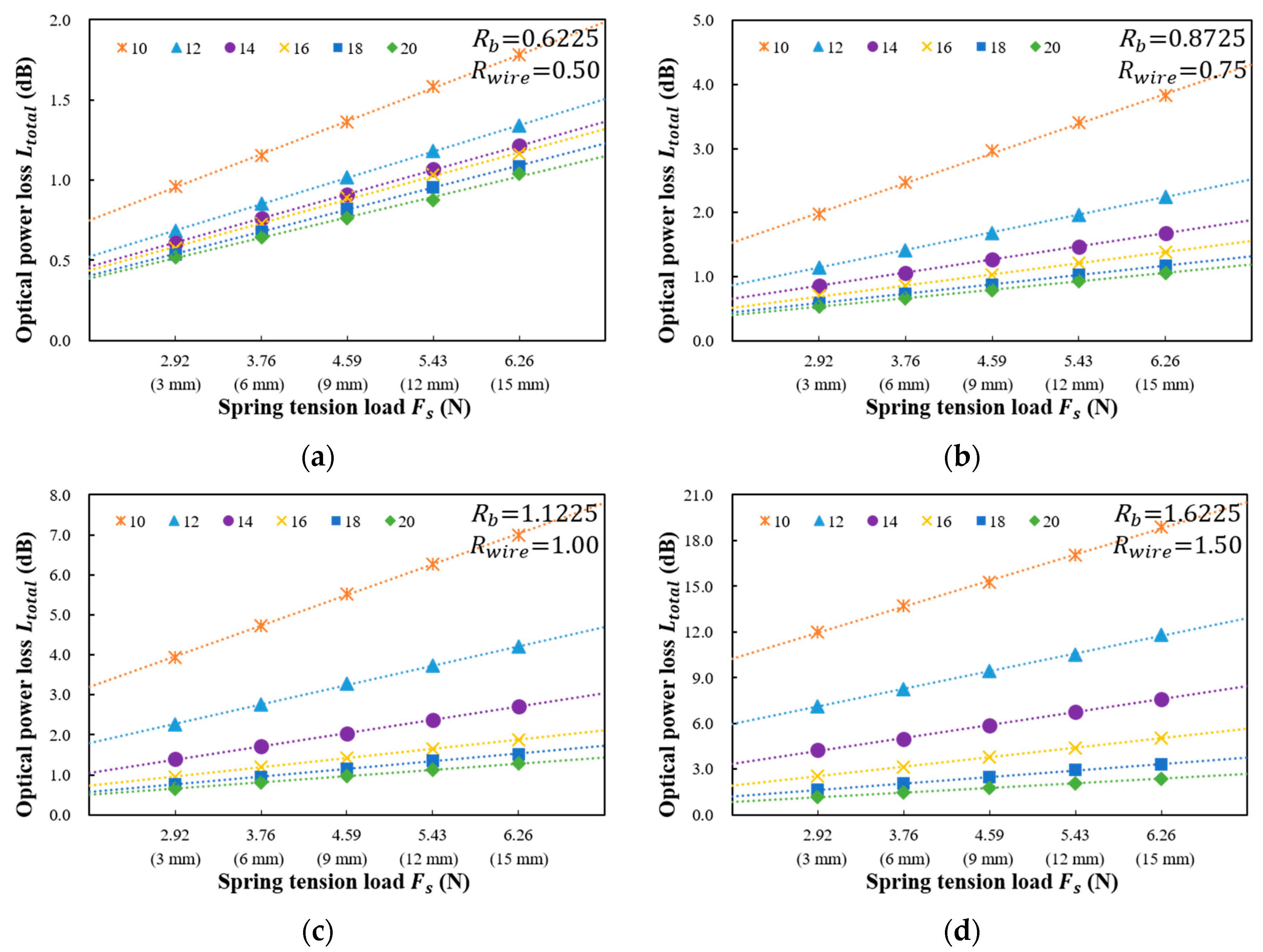






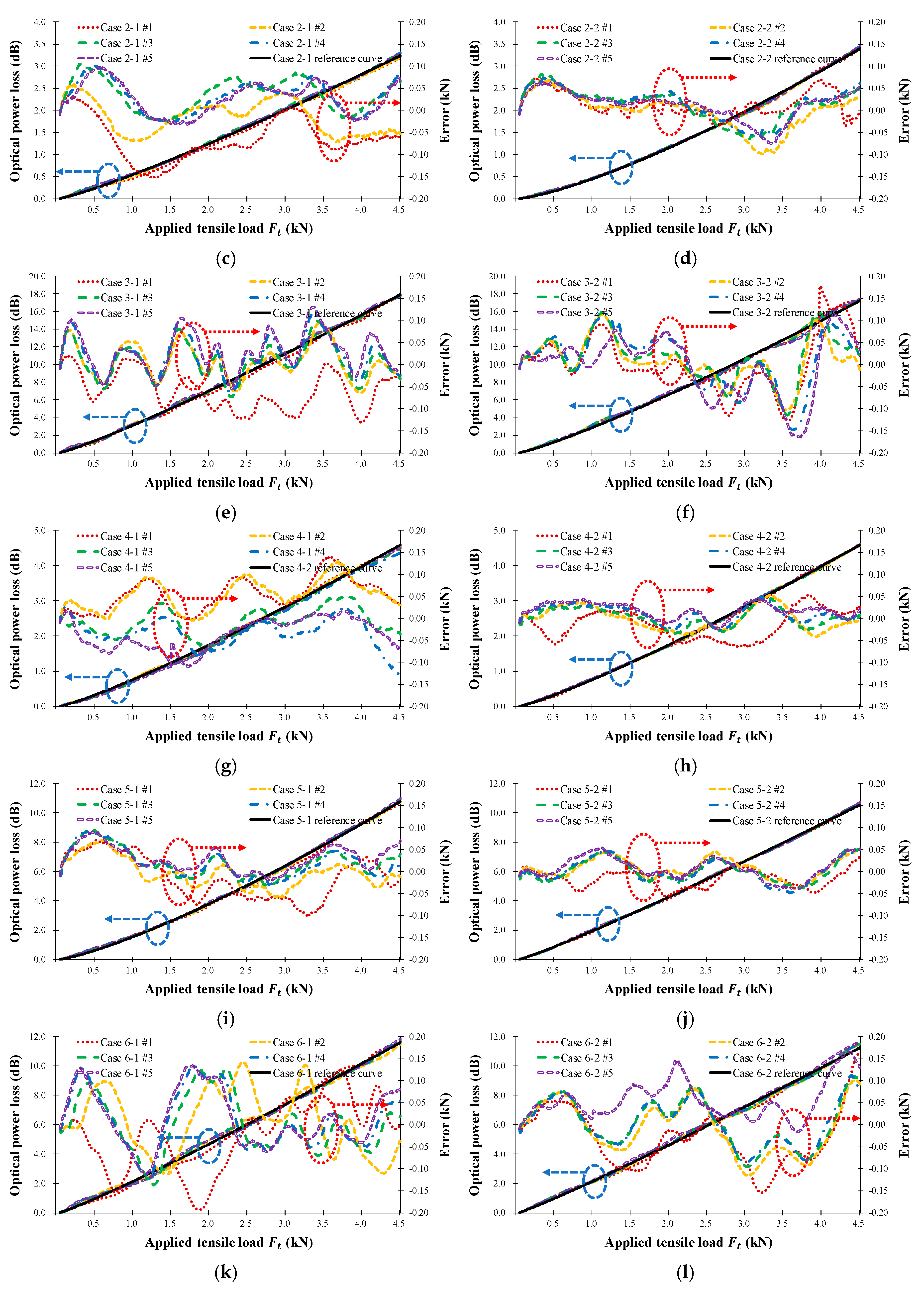


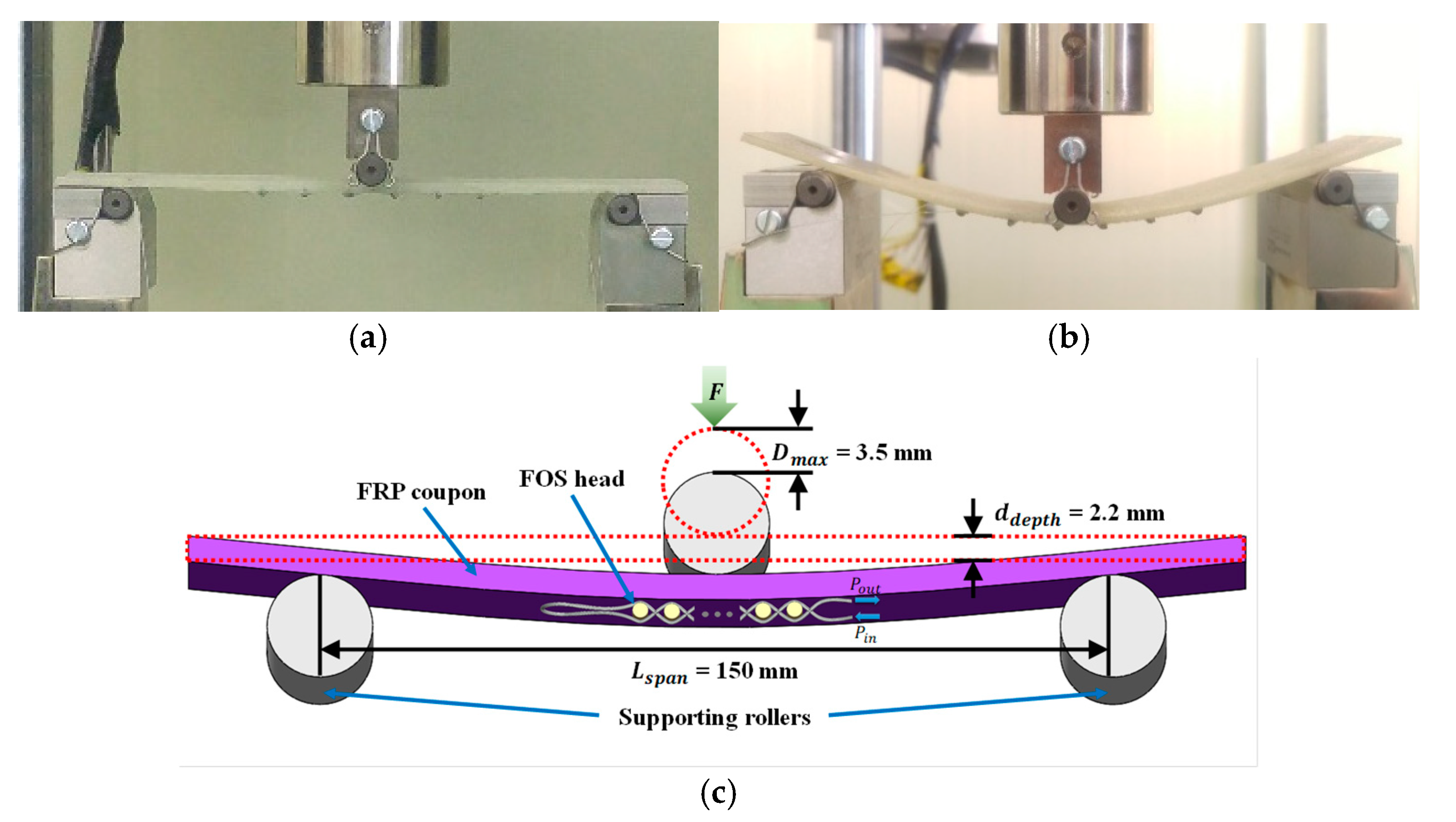
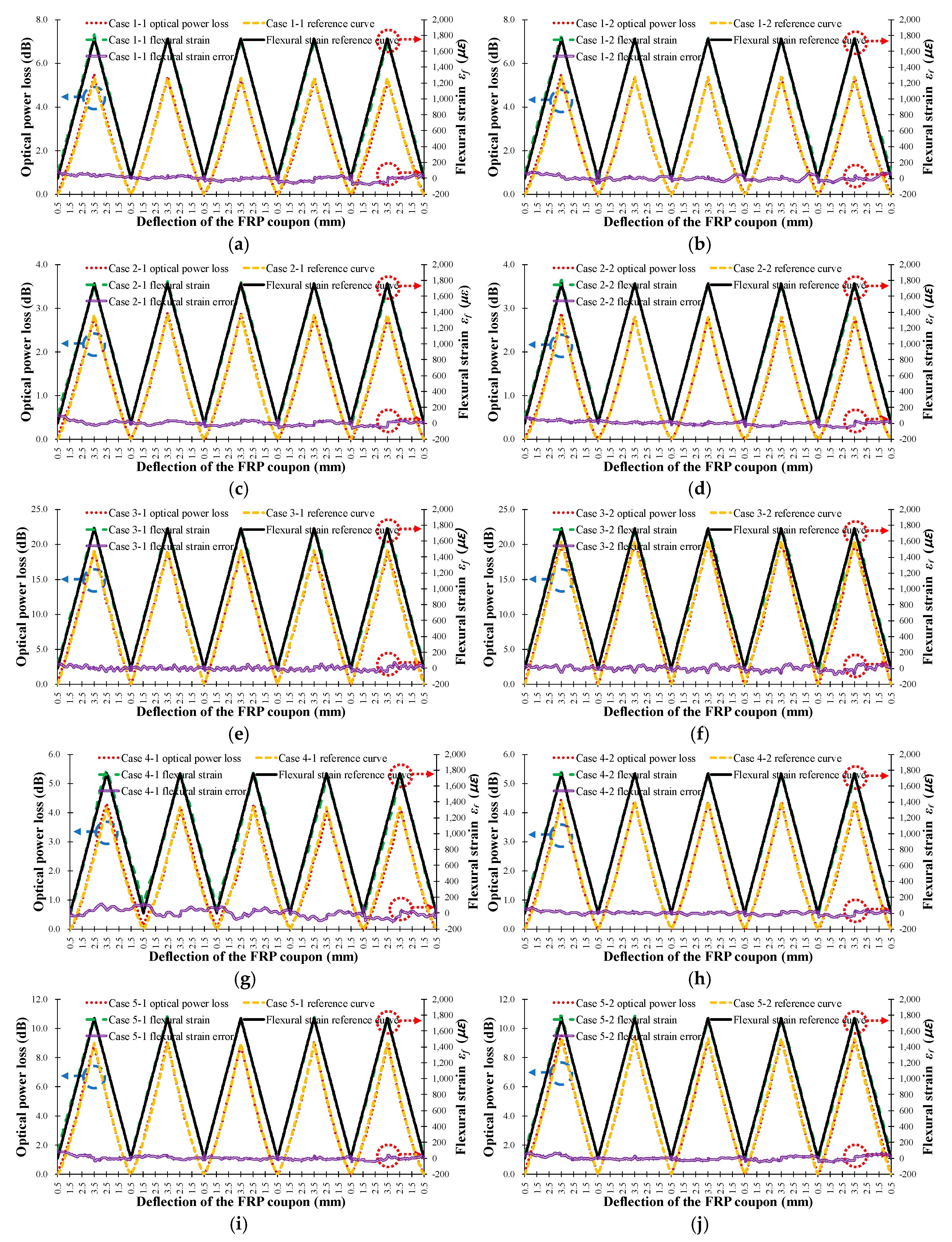

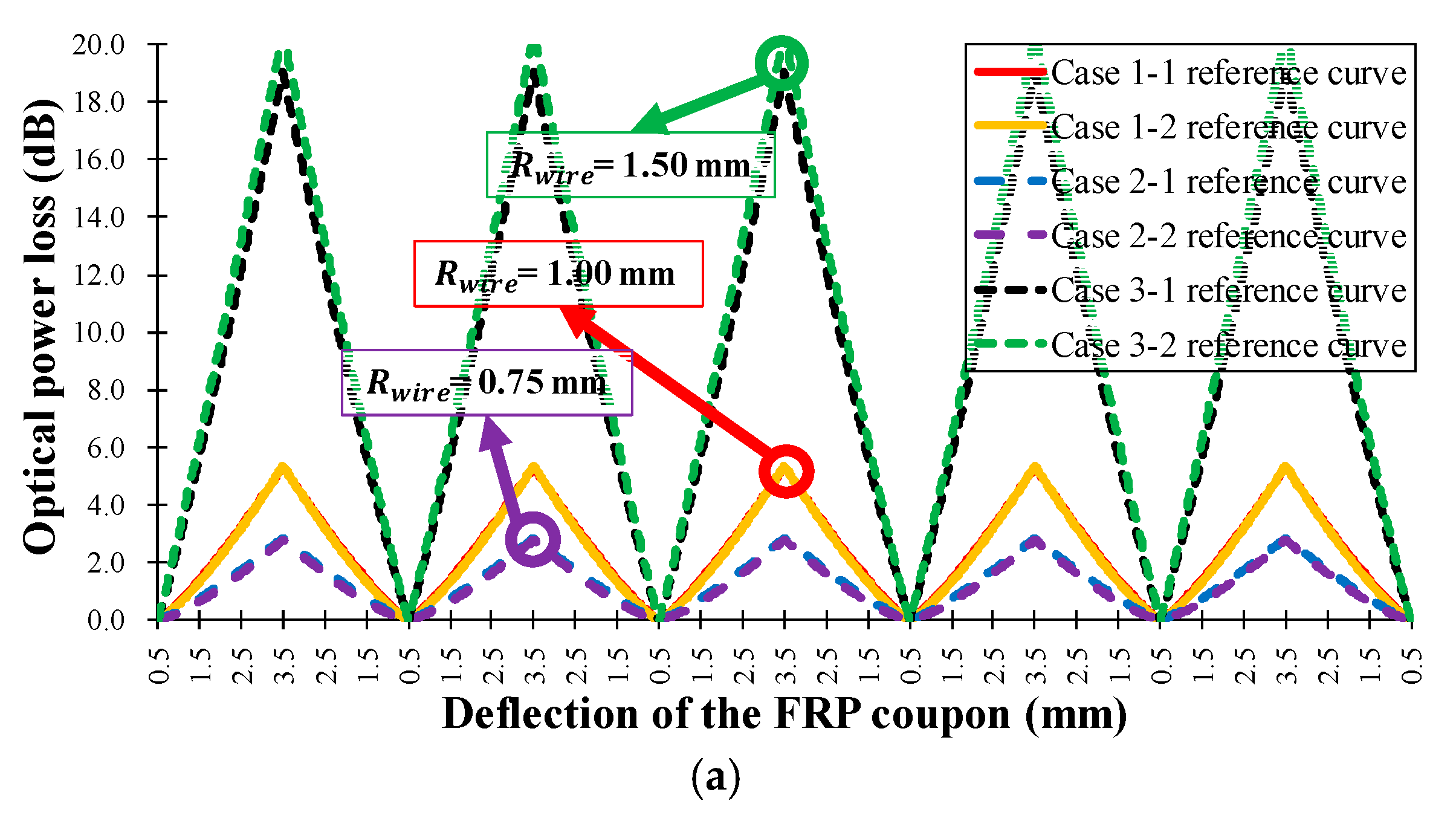
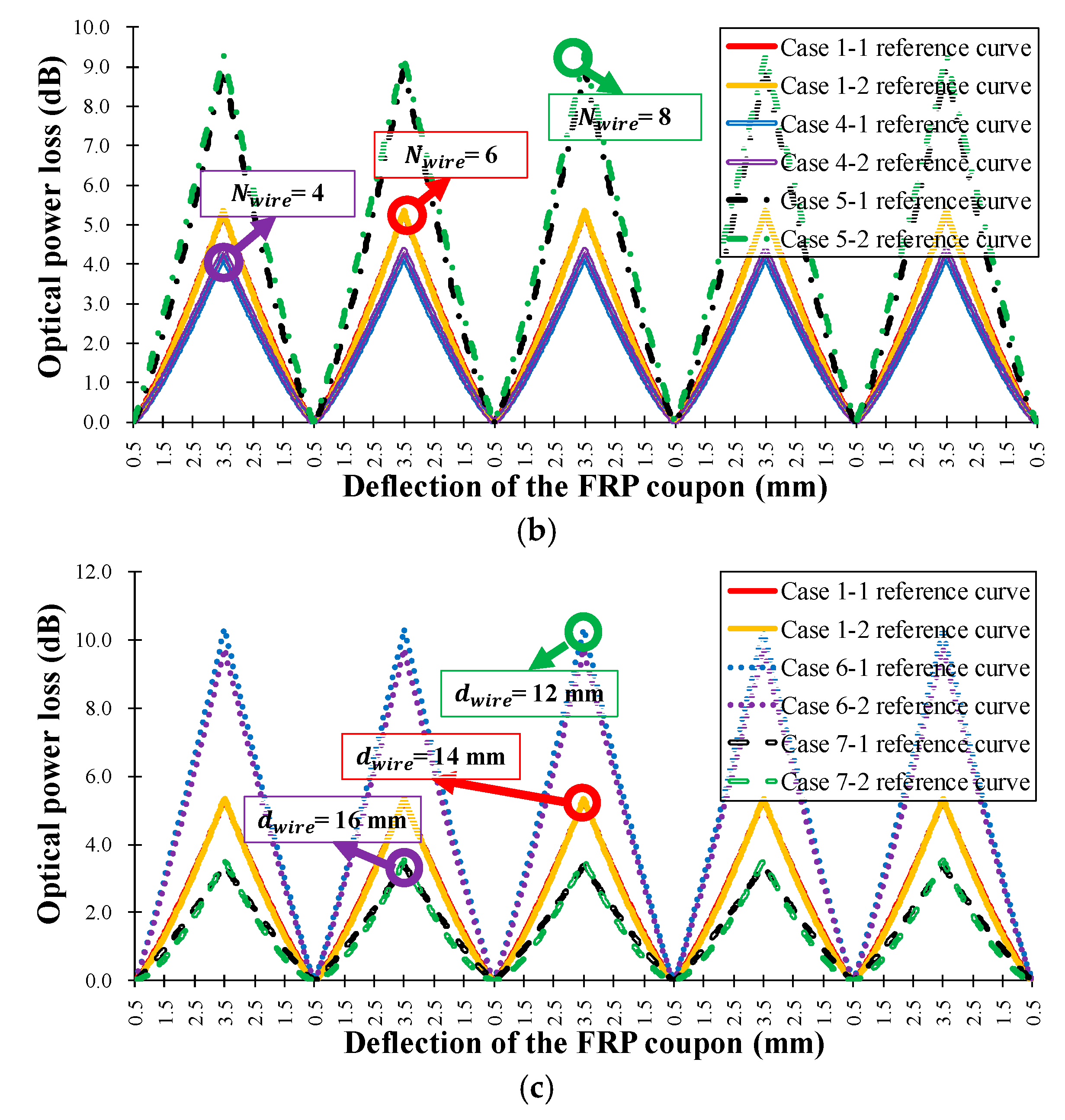
| FOS Heads | Sensor Length (mm) | Insertion Loss (dB) | FOS Heads | Sensor Length (mm) | Insertion Loss (dB) | ||||||
|---|---|---|---|---|---|---|---|---|---|---|---|
| Case 1-1 | 1 | 6 | 14 | 110 | 2.43 | Case 1-2 | 1 | 6 | 14 | 110 | 2.89 |
| Case 2-1 | 0.75 | 6 | 14 | 110 | 1.17 | Case 2-2 | 0.75 | 6 | 14 | 110 | 1.65 |
| Case 3-1 | 1.5 | 6 | 14 | 110 | 9.93 | Case 3-2 | 1.5 | 6 | 14 | 110 | 9.98 |
| Case 4-1 | 1 | 4 | 14 | 82 | 2.43 | Case 4-2 | 1 | 4 | 14 | 82 | 2.56 |
| Case 5-1 | 1 | 8 | 14 | 138 | 2.80 | Case 5-2 | 1 | 8 | 14 | 138 | 3.35 |
| Case 6-1 | 1 | 6 | 12 | 100 | 5.24 | Case 6-2 | 1 | 6 | 12 | 100 | 5.27 |
| Case 7-1 | 1 | 6 | 16 | 120 | 1.42 | Case 7-2 | 1 | 6 | 16 | 120 | 1.61 |
| FOS Heads | Average Sensitivity | Curve Fitting Results ( | Error | ||||
|---|---|---|---|---|---|---|---|
| (dB/kN) | (dB/ | R-Square | RMSE | Average (dB, N, | |||
| Case 1-1 | 1.33 | 0.00294 | 1.1530 | 1.101 | 0.9988 | 0.06000 | 0.046, 34.2, 15.5 |
| Case 1-2 | 1.35 | 0.00299 | 0.9624 | 1.231 | 0.9995 | 0.04020 | 0.034, 24.9, 11.3 |
| Case 2-1 | 0.70 | 0.00155 | 0.5698 | 1.161 | 0.9983 | 0.03962 | 0.032, 45.1, 20.4 |
| Case 2-2 | 0.76 | 0.00168 | 0.4716 | 1.319 | 0.9992 | 0.02768 | 0.023, 30.1, 13.6 |
| Case 3-1 | 3.99 | 0.00883 | 3.2550 | 1.140 | 0.9984 | 0.21370 | 0.164, 41.1, 18.6 |
| Case 3-2 | 3.83 | 0.00847 | 3.0000 | 1.168 | 0.9976 | 0.24810 | 0.180, 46.9, 21.2 |
| Case 4-1 | 1.00 | 0.00221 | 0.7599 | 1.191 | 0.9975 | 0.06675 | 0.042, 42.0, 19.0 |
| Case 4-2 | 1.02 | 0.00226 | 0.7939 | 1.171 | 0.9996 | 0.02755 | 0.022, 21.9, 9.9 |
| Case 5-1 | 2.40 | 0.00531 | 1.6120 | 1.269 | 0.9992 | 0.09092 | 0.077, 32.1, 14.5 |
| Case 5-2 | 2.35 | 0.00520 | 2.0260 | 1.103 | 0.9996 | 0.06102 | 0.048, 20.4, 9.2 |
| Case 6-1 | 2.58 | 0.00571 | 2.2290 | 1.102 | 0.9971 | 0.18360 | 0.149, 57.7, 26.1 |
| Case 6-2 | 2.50 | 0.00553 | 2.2310 | 1.081 | 0.9976 | 0.16090 | 0.129, 51.8, 23.4 |
| Case 7-1 | 1.05 | 0.00232 | 0.4587 | 1.556 | 0.9976 | 0.06938 | 0.060, 57.5, 26.0 |
| Case 7-2 | 1.09 | 0.00241 | 0.4109 | 1.655 | 0.9973 | 0.07569 | 0.060, 55.1, 24.9 |
| FOS Heads | Average Sensitivity | Curve Fitting Results ( | Error | ||||
|---|---|---|---|---|---|---|---|
| (dB/mm) | (dB/ | R-Square | RMSE | Average (dB, | |||
| Case 1-1 | 1.758 | 0.002996 | 43.95 | 1.216 | 0.9958 | 0.10200 | 0.080, 26.59 |
| Case 1-2 | 1.777 | 0.003029 | 49.14 | 1.276 | 0.9972 | 0.08437 | 0.070, 23.11 |
| Case 2-1 | 0.938 | 0.001599 | 23.55 | 1.217 | 0.9973 | 0.04419 | 0.036, 22.62 |
| Case 2-2 | 0.930 | 0.001585 | 29.78 | 1.362 | 0.9975 | 0.04135 | 0.032, 20.44 |
| Case 3-1 | 6.267 | 0.010682 | 129.8 | 1.105 | 0.9981 | 0.24650 | 0.194, 18.17 |
| Case 3-2 | 6.554 | 0.011172 | 131.1 | 1.070 | 0.9969 | 0.33200 | 0.256, 22.88 |
| Case 4-1 | 1.377 | 0.002347 | 36.81 | 1.251 | 0.9902 | 0.12330 | 0.100, 42.58 |
| Case 4-2 | 1.448 | 0.002469 | 36.80 | 1.227 | 0.9984 | 0.05245 | 0.042, 16.90 |
| Case 5-1 | 2.976 | 0.005073 | 70.79 | 1.181 | 0.9983 | 0.10980 | 0.083, 16.30 |
| Case 5-2 | 3.085 | 0.005258 | 66.04 | 1.129 | 0.9974 | 0.13950 | 0.112, 21.30 |
| Case 6-1 | 3.294 | 0.005615 | 70.91 | 1.109 | 0.9964 | 0.18170 | 0.134, 23.92 |
| Case 6-2 | 3.243 | 0.005529 | 69.4 | 1.131 | 0.9983 | 0.11960 | 0.097, 17.58 |
| Case 7-1 | 1.118 | 0.001905 | 45.84 | 1.505 | 0.9981 | 0.04317 | 0.033, 17.09 |
| Case 7-2 | 1.187 | 0.002024 | 50.45 | 1.529 | 0.9963 | 0.06420 | 0.050, 24.83 |
© 2018 by the authors. Licensee MDPI, Basel, Switzerland. This article is an open access article distributed under the terms and conditions of the Creative Commons Attribution (CC BY) license (http://creativecommons.org/licenses/by/4.0/).
Share and Cite
Choi, S.-J.; Jeong, S.-Y.; Lee, C.; Park, K.G.; Pan, J.-K. Twisted Dual-Cycle Fiber Optic Bending Loss Characteristics for Strain Measurement. Sensors 2018, 18, 4009. https://doi.org/10.3390/s18114009
Choi S-J, Jeong S-Y, Lee C, Park KG, Pan J-K. Twisted Dual-Cycle Fiber Optic Bending Loss Characteristics for Strain Measurement. Sensors. 2018; 18(11):4009. https://doi.org/10.3390/s18114009
Chicago/Turabian StyleChoi, Sang-Jin, Seong-Yong Jeong, Changhyun Lee, Kwon Gyu Park, and Jae-Kyung Pan. 2018. "Twisted Dual-Cycle Fiber Optic Bending Loss Characteristics for Strain Measurement" Sensors 18, no. 11: 4009. https://doi.org/10.3390/s18114009





